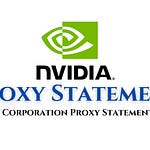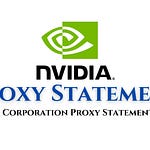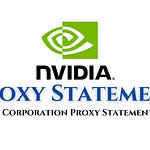Briefing Document: NVIDIA 2019 Annual Review
Source: nVidia Proxy Statement for Stockholders Annual Report 2019
Executive Summary:
NVIDIA's 2019 Annual Report highlights a year of significant growth and technological advancement, driven primarily by its GPU computing platform. The company achieved record revenue and expanded gross margins, while also returning substantial value to shareholders. Key themes include the transformative impact of their Turing architecture on computer graphics with real-time ray tracing (RTX), their strategic positioning in the autonomous driving market through the DRIVE platform, and their continued dominance in high-performance computing and AI. Despite navigating "turbulent times," the report emphasizes NVIDIA's strong financial performance and strategic focus on leveraging their core GPU technology across diverse, high-growth markets. The report also provides insights into their corporate governance, executive compensation structure, and ongoing legal and regulatory considerations.
Key Themes and Important Ideas/Facts:
Strong Financial Performance in FY2019:
Revenue rose 21% to $11.72 billion.
Gross margins expanded to 61.2%, a 130 basis point increase.
GAAP earnings per share (EPS) were $6.63, up 38%.
The company returned $1.95 billion to shareholders through dividends and share repurchases.
Revenue growth was primarily driven by the GPU segment, which increased by 25% to $10,175 million. The Tegra Processor segment saw minimal growth (7 million).
International sales accounted for 87% of total revenue, with China (including Hong Kong) representing 24% of revenue.
Advancements in Computer Graphics (Turing and RTX):
The introduction of the Turing architecture is highlighted as a major achievement, "reinventing computer graphics."
Turing enables real-time ray tracing through the RTX platform, a long-standing goal in the industry. The report states, "Turing makes this dream possible by combining inventions in ray tracing, AI, and programmable shading in a new approach to graphics we named RTX."
Microsoft adopted ray tracing in their next major Windows API, DirectX Raytracing (DXR), facilitating adoption in next-generation games.
NVIDIA expanded its RTX lineup with the GeForce RTX 2060 for the mass market and announced over 40 new models of GeForce RTX gaming notebooks, utilizing Max-Q technology for power optimization in thin and sleek designs.
Strategic Focus on Autonomous Driving (DRIVE Platform):
NVIDIA's auto business grew 15% to a record $641 million in FY2019, fueled by the adoption of next-generation AI capabilities in vehicles.
Their strategy is to provide a platform for autonomous driving for transportation companies worldwide, rather than building self-driving cars themselves.
The NVIDIA DRIVE platform is comprehensive, including AI development systems (DGX), a virtual reality simulator (DRIVE Constellation), an autopilot computer (DRIVE AP2X), software stacks (DRIVE AV and DRIVE IX), and a fleet of mapping and testing cars (BB8).
A significant milestone was the completion of a "first hands-free, 50-mile loop around the San Francisco Bay Area with BB8."
The DRIVE AutoPilot, a commercially available Level 2-plus self-driving car computer, was announced at CES 2019 and selected by companies like Volvo, Continental, and ZF.
Leadership in High-Performance Computing and AI:
NVIDIA GPUs are accelerating a growing number of supercomputers. The Summit supercomputer, the world's fastest at the time, used over 27,000 NVIDIA V100 GPUs.
NVIDIA added 41 new systems to the TOP500 list, bringing their total to 127 supercomputers accelerated by NVIDIA.
NVIDIA accelerates three key workloads in the "new HPC" market: AI applications (cloud service providers), scientific computing (supercomputing labs), and enterprise data analytics and machine learning (various industries).
The company offers a family of GPUs for speeding up training and inferencing of neural networks, available in industry-standard servers, major cloud service providers, and their own DGX AI supercomputer.
They also provide the NVIDIA GPU Cloud (NGC), a catalog of optimized software stacks for scientific computing, deep learning, and machine learning.
Platform Strategy and Intellectual Property:
NVIDIA employs a platform strategy, integrating hardware, system software, programmable algorithms, libraries, systems, and services, all built upon a unified underlying architecture using GPUs and CUDA.
This programmable architecture allows them to address multiple multi-billion dollar markets with the same core technology, leveraging R&D investments.
Key product brands include GeForce (gamers), Quadro (designers), Tesla and DGX (AI/big data), and GRID (cloud-based visual computing) under the GPU segment, and Tegra processors (DRIVE, Clara AGX, SHIELD, Jetson AGX) for embedded systems.
They rely on a combination of patents, trademarks, trade secrets, and licensing agreements to protect their intellectual property.
NVIDIA licenses technology from third parties and may engage in licensing and development agreements to expand the reach of their technology.
Corporate Governance and Executive Compensation:
The report lists the members of the Board of Directors, including co-founder Jen-Hsun Huang (President and CEO), and provides brief biographical information and committee memberships.
Information on executive compensation, including stock options, RSUs, and PSUs held by non-employee directors and named executive officers (NEOs), is provided.
The executive compensation plan includes SY PSUs (Single Year Performance Stock Units) and MY PSUs (Multi-Year Performance Stock Units) tied to performance goals like Non-GAAP Operating Income and Total Shareholder Return (TSR) relative to the S&P 500.
For FY2019, while achieving record Non-GAAP Operating Income, 90% of SY PSUs granted became eligible to vest.
For MY PSUs granted in FY2017, NVIDIA's TSR over the three-year period was 426%, representing the 100th percentile of companies in the S&P 500, resulting in the maximum number of MY PSUs becoming eligible to vest (150% for Mr. Huang, 200% for other NEOs).
The compensation plan includes provisions like a compensation recovery policy, multi-year vesting for executive officer equity awards, stock ownership guidelines, and "no-hedging" and "no-pledging" policies for common stock.
Risks and Legal Matters:
The company highlights being "subject to multiple lawsuits, regulatory matters, and new regulations."
Specific ongoing litigation includes patent infringement lawsuits filed by Polaris Innovations Limited and ZiiLabs Inc., Ltd., related to DRAM control and GPUs, respectively. While an agreement was reached with ZiiLabs for a license and dismissal, the Polaris litigation was ongoing in the US and Germany at the time.
NVIDIA also faces securities litigation claims based on allegations related to channel inventory and the impact of cryptocurrency mining on GPU demand.
Other risks include the ability to adequately protect their intellectual property rights, which can incur substantial costs and potentially harm their ability to compete.
There are risks associated with international operations, given their worldwide business and significant revenue generated outside the United States.
Failure to properly estimate customer demand can lead to excess or obsolete inventory, impacting financial results. This was experienced with mid-range gaming GPUs in FY2019.
Company Philosophy and Purpose:
The letter to "NVIDIANS AND STAKEHOLDERS" emphasizes the company's role in creating "essential instruments of scientists, researchers, artists, and creators."
They see themselves as making "tools with amazing and incredible possibilities," enabling the "Einsteins and da Vincis of our time to help them see and create the future."
Despite a "turbulent" year, the company believes the strides made have positioned them "solidly for the future."
Quotes of Note:
"NVIDIA IS TAKING OVER THE AUTONOMOUS DRIVING INDUSTRY" - THE STREET (Quoted in the report)
"Turing has arrived and is reinventing computer graphics."
"Once you experience the heart-pounding realism of real-time ray-traced graphics, you can’t go back."
"Our strategy is not to build self-driving cars, but to create a platform for every transportation company in the world to build them."
"The computers NVIDIA makes are the essential instruments of scientists, researchers, artists, and creators."
"This year will stand as one of the most extraordinary in our company’s history. It was surely turbulent. Yet it was a year when we did some of our best work ever."
Conclusion:
The NVIDIA 2019 Annual Report paints a picture of a dynamic and successful company at the forefront of GPU technology, leveraging its core expertise to drive innovation and growth across multiple high-value markets including gaming, professional visualization, datacenter, and automotive. While facing legal challenges and market fluctuations (particularly in inventory management), the company demonstrated strong financial performance and a clear strategic vision centered on its platform approach and commitment to advancing GPU computing for diverse applications. The report underscores their ambition to be a fundamental enabler of technological progress for a wide range of users and industries.













Share this post